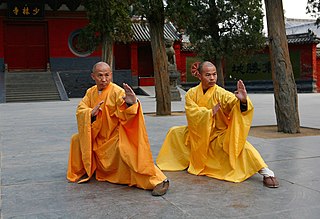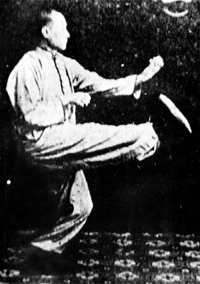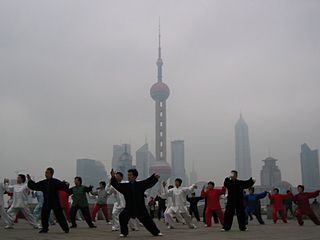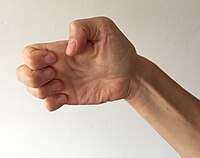
Hung Ga (洪家), Hung Kuen (洪拳), or Hung Ga Kuen (洪家拳) is a southern Chinese martial art belonging to the southern Shaolin styles. The hallmarks of Hung Ga are strong stances, notably the horse stance, or "si ping ma" (四平馬), and strong hand techniques, notably the bridge hand and the versatile tiger claw. Traditionally, students spent anywhere from several months to three years in stance training, often sitting only in horse stance from half an hour to several hours at a time, before learning any forms. Each form could then take a year or so to learn, with weapons learned last. In current times, this mode of instruction is generally considered impractical for students, who have other concerns beyond practicing kung fu. However, some instructors still follow traditional guidelines and make stance training the majority of their beginner training. Hung Ga is sometimes mischaracterized as solely external—that is, reliant on brute physical force rather than the cultivation of qi—even though the student advances progressively toward an internal focus.

Eagle Claw is a style of Chinese martial arts known for its gripping techniques, system of joint locks, takedowns, and pressure point strikes, which is representative of Chinese grappling known as Chin Na. The style is normally attributed to the famous patriotic Song dynasty General Yue Fei. Popular legends states that he learned martial arts from a Wudang Monk named Zhou Tong and later created Eagle Claw to help his armies combat the invading armies of the Jin dynasty. It was passed down until the Ming dynasty. Thus, the style took on long range strikes and aerial jumps. During the Qing dynasty, the military instructor Liu Shi Jun became known as the modern progenitor of Eagle Claw and taught many students. His student Liu Cheng You later taught Chen Zizheng who was invited to teach the style in the prestigious Chin Woo Athletic Association during the Republican era. The style spread as Chin Woo opened sister schools in other provinces. Today, it is practiced around the world.

Northern Praying Mantis is a style of Chinese martial arts, sometimes called Shandong Praying Mantis after its province of origin. It is one of the best known styles of "Northern" kung fu and it encompasses of many styles, with the three main ones being the six-harmony style, eight-steps style and seven-star style.

The movements of the Southern Dragon style of Shaolin Boxing are based on the mythical Chinese dragon. The Dragon style is an imitative-style that was developed based on the imagined characteristics of the mythical Chinese dragon.

Ten Tigers of Canton or Ten Tigers of Guangdong refers to a group of ten Chinese martial artists from Guangdong Province lived around the 19th century during the Qing dynasty in China. They were said to be the greatest fighters in Guangdong during the Qing era. Much of their existence has been embellished by folk legends and stories passed down from generation to generation.

Changquan refers to a family of external martial arts styles from northern China.

Fanziquan is a Chinese martial art that emphasizes offense and defense with the hands. Its movements have been described as:
"Leopard Blow," "leopard punch," and "leopard fist" are common terms for a specific type of striking blow, associated primarily with the Leopard Kung Fu substyle of the Five Animals in Chinese martial arts, though it is also used in styles such as Krav Maga, Choy Li Fut and Karate. The maneuver involves folding the first two joints of the fingers inward and striking with the fore-knuckles. It is used most often to strike at soft, vulnerable targets, such as the ribs, throat, inner arms and temples.

In its broadest sense, Northern Shaolin is the external martial arts of Northern China, referring to those styles from the Northern Shaolin Monastery in Henan and specifically to the style practice by Gù Rǔzhāng, the Sōngshān Shí Lù Shàolínquán (嵩山十路少林拳) / Song Mountain Ten Road Shaolin Boxing.

In Chinese martial arts, there are fighting styles that are modeled after animals.

The horse stance is a common posture in Asian martial arts. It is called mǎbù (馬步) in Chinese, kiba-dachi (騎馬立ち) in Japanese, and juchum seogi or annun seogi in Korean. This stance can not only be integrated into fighting but also during exercises and forms. It is most commonly used for practicing punches or to strengthen the legs and back. The modified form of horse stance, in which heels are raised, is a fighting stance in International Karate Tournaments. The Chinese form of horse stance is a fighting stance which changes into front stance while using hip rotation to develop punching force.

Kung Fu San Soo (功夫散手) is a Chinese-American martial art. It is based on techniques from all over China, both Northern and Southern Chinese martial arts systems.

Drunken Monkey Form or Drunken Monkey Pole Form of Kung Fu is a Chinese martial art, a variation of the Monkey Style.

Jow Ga kung fu is a form of Chinese martial art. It was founded by Jow Lung who was born in 1891, on the eleventh day of the third lunar month in Sa Fu Village of the Guangdong province, and died in 1919. His father was Jow Fong Hoy and his mother’s maiden name was Li. At the time of its inception, this particular style of kung fu was labeled as having the head of Hung Gar, the tail of Choy Gar and the patterns of the tiger and leopard, or simply Hung Tao Choy Mei. It was so labeled because the essential techniques incorporated the muscular and mighty movements of Hung Gar and the swift footwork and complex kicking of Choy Gar, making it a very effective form of self defense with emphasis on simultaneous attack and defense.

There are hundreds of different styles of Chinese martial arts, each with their own sets of techniques and ideas. The various movements in kung fu, most of which are imitations of the fighting styles of animals, are initiated from one to five basic foot positions: normal upright posture and the four stances called dragon, frog, horse riding, and snake.

The Li family of kung fu is one of the five family styles of Southern Chinese martial arts.

Choy Gar, also Caijia Quan, is a Chinese martial art deriving its name from the Cantonese-born founder, Choy Gau Lee (蔡九儀), and is one of the five main family styles of Kung Fu in Southern China. It was taught to him by a monk named Yi Guan. This style, founded in the 17th century, is a combination of rat and snake styles emphasizing on swift footwork and rapid strikes.

Shaolin Kenpo Karate is a martial art style that combines the Five Animals of Shaolin Kung Fu (Shaolinquan), the core competency of Kenpo, the hard-hitting linear explosiveness of traditional Karate, as well as the power of Western boxing and the felling and grappling arts of Jujutsu, Chin Na, and Mongolian wrestling. This system was founded and developed by Fredrick J. Villari, who devised a hybrid system which integrated the four ways of fighting: striking, kicking, felling, and grappling to eliminate the inherent weakness of martial arts systems that focus on just one or two of fighting techniques.

Snake kung fu is a Shaolin boxing style, one of several Chinese martial arts known as "snake boxing" or "fanged snake style" that imitate the movements of snakes. Proponents claim that adopting the fluidity of snakes allows them to entwine with their opponents in defense and strike them from angles they would not expect in offense. Snake style is said to especially lend itself to applications with the Chinese straight sword. The snake is also one of the animals imitated in Yang-style tai chi, Baguazhang and Xingyiquan. The sinuous, fluid motion of the snake lends itself to the practical theory that underlies the "soft" martial arts.










